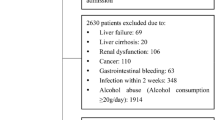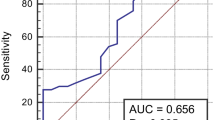Abstract
Whether subclinical change of liver function is associated with outcome of spontaneous intracerebral hemorrhage remains to be an open question. A total of 639 patients of spontaneous intracerebral hemorrhage within 7 days from stroke onset were finally enrolled. Liver function indicators, including alanine aminotransferase (ALT), aspartate aminotransferase (AST), bilirubin (BIL), alkaline phosphatase (ALP), gamma glutamyl transpeptidase (GGT), albumin (ALB), and international normalized ratio (INR), were collected and collapsed into quartiles. The main outcomes were 30-day death, 90-day death, and 90-day poor outcome (modified Rankin Scale score of 3–6). Two adjusted model, Model 1 and Model 2 (Model 1 plus GCS score), were established to identify independent association between liver function indicators and ICH outcomes. The mortality rate was 19.9 % (127/639) at 30 days and 21.3 % (136/639) at 90 days. Rate of 90-day poor outcome was 51.5 % (329/639). Among liver function indicators, AST and ALP were associated with all the three outcomes, which did not alter significantly when adjusted by Model 1. After adjusted by Model 2, ALP was still associated with outcomes. Association between AST and outcomes was, however, weakened significantly by GCS score. In conclusions, among liver function indicators, AST and ALP were associated with outcomes after spontaneous intracerebral hemorrhage.


Similar content being viewed by others
References
Qureshi AI, Mendelow AD, Hanley DF (2009) Intracerebral haemorrhage. Lancet 373:1632–1644
Morgenstern LB, Hemphill JC 3rd, Anderson C, Becker K, Broderick JP, Connolly ES Jr et al (2010) Guidelines for the management of spontaneous intracerebral hemorrhage: a guideline for healthcare professionals from the American Heart Association/American Stroke Association. Stroke 41:2108–2129
Steiner T, Al-Shahi Salman R, Beer R, Christensen H, Cordonnier C, Csiba L et al (2014) European stroke organisation (ESO) guidelines for the management of spontaneous intracerebral hemorrhage. Int J Stroke 9:840–855
Hoekstra LT, de Graaf W, Nibourg GA, Heger M, Bennink RJ, Stieger B et al (2013) Physiological and biochemical basis of clinical liver function tests: a review. Ann Surg 257:27–36
Ebrahimkhani MR, Neiman JA, Raredon MS, Hughes DJ, Griffith LG (2014) Bioreactor technologies to support liver function in vitro. Adv Drug Deliv Rev 69–70:132–157
Fujii Y, Takeuchi S, Tanaka R, Koike T, Sasaki O, Minakawa T (1994) Liver dysfunction in spontaneous intracerebral hemorrhage. Neurosurgery 35:592–596
Fujii Y, Tanaka R, Takeuchi S, Koike T, Minakawa T, Sasaki O (1994) Hematoma enlargement in spontaneous intracerebral hemorrhage. J Neurosurg 80:51–57
Niizuma H, Shimizu Y, Nakasato N, Jokura H, Suzuki J (1988) Influence of liver dysfunction on volume of putaminal hemorrhage. Stroke 19:987–990
Huang HH, Lin HH, Shih YL, Chen PJ, Chang WK, Chu HC et al (2008) Spontaneous intracranial hemorrhage in cirrhotic patients. Clin Neurol Neurosurg 110:253–258
Boudouresques G, Hauw JJ, Meininger V, Escourolle R, Pertuiset B, Buge A et al (1980) Hepatic cirrhosis and intracranial hemorrhage: significance of the association in 53 pathological cases. Ann Neurol 8:204–205
Niizuma H, Suzuki J, Yonemitsu T, Otsuki T (1988) Spontaneous intracerebral hemorrhage and liver dysfunction. Stroke 19:852–856
Ryu WS, Lee SH, Kim CK, Kim BJ, Yoon BW (2010) Increased serum alkaline phosphatase as a predictor of long-term mortality after stroke. Neurology 75:1995–2002
Ruttmann E, Brant LJ, Concin H, Diem G, Rapp K, Ulmer H (2005) Gamma-glutamyltransferase as a risk factor for cardiovascular disease mortality: an epidemiological investigation in a cohort of 163,944 Austrian adults. Circulation 112:2130–2137
Kim KH (2009) Predictors of 30-day mortality and 90-day functional recovery after primary intracerebral hemorrhage: hospital based multivariate analysis in 585 patients. J Korean Neurosurg Soc 45:341–349
Perlstein TS, Pande RL, Creager MA, Weuve J, Beckman JA (2008) Serum total bilirubin level, prevalent stroke, and stroke outcomes: NHANES 1999–2004. Am J Med 121(781–788):e781
Fang HY, Lin CY, Ko WJ (2005) Hematology and coagulation parameters predict outcome in Taiwanese patients with spontaneous intracerebral hemorrhage. Eur J Neurol 12:226–232
Ryu WS, Lee SH, Kim CK, Kim BJ, Kwon HM, Yoon BW (2014) High serum alkaline phosphatase in relation to cerebral small vessel disease. Atherosclerosis 232:313–318
Kim J, Song TJ, Song D, Lee HS, Nam CM, Nam HS et al (2013) Serum alkaline phosphatase and phosphate in cerebral atherosclerosis and functional outcomes after cerebral infarction. Stroke 44:3547–3549
Tonelli M, Curhan G, Pfeffer M, Sacks F, Thadhani R, Melamed ML et al (2009) Relation between alkaline phosphatase, serum phosphate, and all-cause or cardiovascular mortality. Circulation 120:1784–1792
Loftspring MC, Johnson HL, Feng R, Johnson AJ, Clark JF (2011) Unconjugated bilirubin contributes to early inflammation and edema after intracerebral hemorrhage. J Cereb Blood Flow Metab 31:1133–1142
Stocker R, Yamamoto Y, McDonagh AF, Glazer AN, Ames BN (1987) Bilirubin is an antioxidant of possible physiological importance. Science 235:1043–1046
Senn R, Elkind MS, Montaner J, Christ-Crain M, Katan M (2014) Potential role of blood biomarkers in the management of nontraumatic intracerebral hemorrhage. Cerebrovasc Dis 38:395–409
Campos F, Sobrino T, Ramos-Cabrer P, Castellanos M, Blanco M, Rodriguez-Yanez M et al (2011) High blood glutamate oxaloacetate transaminase levels are associated with good functional outcome in acute ischemic stroke. J Cereb Blood Flow Metab 31:1387–1393
Chakraborty B, Vishnoi G, Goswami B, Gowda SH, Chowdhury D, Agarwal S (2013) Lipoprotein(a), ferritin, and albumin in acute phase reaction predicts severity and mortality of acute ischemic stroke in North Indian Patients. J Stroke Cerebrovasc Dis 22:e159–e167
Turhan N, Saracgil N, Oztop P, Bayramoglu M (2006) Serum albumin and comorbidity relative to rehabilitation outcome in geriatric stroke, and possible links with stroke etiology. Int J Rehabil Res 29:81–85
van Swieten JC, Koudstaal PJ, Visser MC, Schouten HJ, van Gijn J (1988) Interobserver agreement for the assessment of handicap in stroke patients. Stroke 19:604–607
Falcone GJ, Biffi A, Brouwers HB, Anderson CD, Battey TW, Ayres AM et al (2013) Predictors of hematoma volume in deep and lobar supratentorial intracerebral hemorrhage. JAMA Neurol 70:988–994
Zis P, Leivadeas P, Michas D, Kravaritis D, Angelidakis P, Tavernarakis A (2014) Predicting 30-day case fatality of primary inoperable intracerebral hemorrhage based on findings at the emergency department. J Stroke Cerebrovasc Dis 23:1928–1933
Sousa LD, Zorrilla JP, Latini MF, Alvarez Abut P, Ayala M, Romano LM et al (2011) Is the international normalised ratio a prognostic factor of mortality in intracerebral haemorrhage? Neurologia 26:528–532
Mansouri B, Heidari K, Asadollahi S, Nazari M, Assarzadegan F, Amini A (2013) Mortality and functional disability after spontaneous intracranial hemorrhage: the predictive impact of overall admission factors. Neurol Sci 34:1933–1939
Campos F, Rodriguez-Yanez M, Castellanos M, Arias S, Perez-Mato M, Sobrino T et al (2011) Blood levels of glutamate oxaloacetate transaminase are more strongly associated with good outcome in acute ischaemic stroke than glutamate pyruvate transaminase levels. Clin Sci (Lond) 121:11–17
Hemphill JC 3rd, Bonovich DC, Besmertis L, Manley GT, Johnston SC (2001) The ICH score: a simple, reliable grading scale for intracerebral hemorrhage. Stroke 32:891–897
Gurbuzer N, Gozke E (2014) Gamma-glutamyl transferase levels in patients with acute ischemic stroke. Cardiovasc Psychiatry Neurol 2014:170626
Pompella A, Emdin M, Passino C, Paolicchi A (2004) The significance of serum gamma-glutamyltransferase in cardiovascular diseases. Clin Chem Lab Med 42:1085–1091
Ginsberg MD, Palesch YY, Hill MD, Martin RH, Moy CS, Barsan WG et al (2013) High-dose albumin treatment for acute ischaemic stroke (ALIAS) Part 2: a randomised, double-blind, phase 3, placebo-controlled trial. Lancet Neurol 12:1049–1058
Acknowledgments
This study was supported by the National Key Technology R&D Program for the 12th Five-Year Plan of People’s Republic of China (2011BAI08B05).
Author information
Authors and Affiliations
Corresponding author
Ethics declarations
Conflict of interest
The authors declare that they have no conflict of interest.
Ethical approval
All procedures performed in studies involving human participants were in accordance with the ethical standards of the institutional and/or national research committee and with the 1964 Helsinki declaration and its later amendments or comparable ethical standards.
Electronic supplementary material
Below is the link to the electronic supplementary material.
Rights and permissions
About this article
Cite this article
Tan, G., Hao, Z., Lei, C. et al. Subclinical change of liver function could also provide a clue on prognosis for patients with spontaneous intracerebral hemorrhage. Neurol Sci 37, 1693–1700 (2016). https://doi.org/10.1007/s10072-016-2656-0
Received:
Accepted:
Published:
Issue Date:
DOI: https://doi.org/10.1007/s10072-016-2656-0




